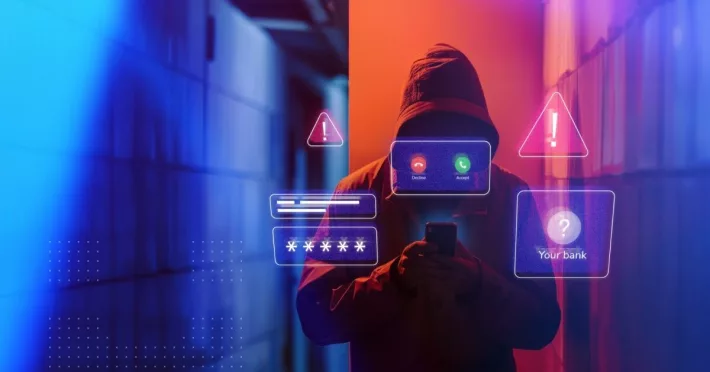In the ever-evolving digital landscape, scams and fraudulent activities have become more prevalent, with voice call frauds like vishing emerging as a particularly insidious threat.
In this article AB Handshake delves into the complexities of vishing scams and explores innovative anti-vishing solutions to mitigate these risks.
What Is Vishing?
Vishing, or voice phishing, involves fraudsters impersonating legitimate entities over phone calls to deceive unsuspecting individuals into divulging sensitive information such as financial details, passwords, or personal identification numbers.
Vishing is a major issue in the telecom industry. In 2021 alone, the USA experienced 59.4 million victims with a $29.8 billion loss due to vishing. Mobile phones were the primary target in 85% of cases, and number spoofing was common, accounting for 70% of incidents.
As seen from the statistics, the sophistication of vishing attacks is extraordinary, posing significant challenges for banks, brands, telecom operators, and their customers.
Vishing Tactics Not to Overlook
One of the primary tactics employed by vishing scammers is impersonation. Fraudsters utilise various techniques to create a false sense of legitimacy, including spoofing caller ID to display a familiar or trusted number, impersonating reputable organisations or brands.
Another technique involves employing generative AI to mimic known voices. These tactics are meticulously crafted to exploit the inherent trust individuals place in recognisable entities.
Databases Can’t Detect Vishing
What makes combating vishing challenging is the utilisation of seemingly legitimate phone numbers. Fraudsters use allocated and assigned numbers that are marked as “unsuspicious” in number intelligence databases. Shockingly, AB Handshake’s research
indicates that a staggering 75% of fraud attacks involve genuine numbers associated with real persons or reputable brands and banks.
This masking of fraudulent activities in legitimate channels makes it impossible for traditional databases to detect and prevent vishing attacks. Moreover, fraudulent calls often originate from abroad, complicating the trace-back and identification process.
Modern Solutions against Vishing
To combat vishing, modern anti-fraud solutions with advanced technologies are crucial. Artificial intelligence (AI) has emerged as a potent tool in detecting and mitigating vishing attacks.
AI-based systems analyse vast volumes of voice traffic, checking hundreds of parameters to detect patterns indicative of fraudulent activity. By identifying anomalous behaviour and suspicious patterns, these cutting-edge solutions enhance fraud detection capabilities and fortify defenses against vishing scams.
However, it’s important to acknowledge the limitations of AI-based systems. While effective in detecting mass fraud campaigns, they may prove ineffective when dealing with whaling — a targeted form of phishing that specifically targets high-profile individuals within an organisation.
Here is where real-time validation comes into rescue.
Real-Time Validation for Ultimate Vishing Protection
Real-time validation of all incoming calls has emerged as a powerful tool in the arsenal against vishing and whaling attacks.
Here’s how it operates: When a telecom service provider receives an incoming call, the validation system in real time checks with the brand owner to confirm if it’s a legitimate brand call. If confirmed, the call is validated and directed to the end-user; if not, the call can be blocked or flagged as suspicious.
This proactive strategy empowers telecom operators to intercept potentially fraudulent calls before they reach end-users, providing a crucial layer of defence and safeguarding individuals from falling prey to vishing schemes.
ITU on Vishing
In response to the escalating challenges posed by voice traffic fraud, particularly vishing, the International Telecommunication Union (ITU) took a significant step in December 2023.
After analysing data provided by AB Handshake, the ITU issued a communiqué highlighting the critical need for standardisation in real-time validation of calls. The declaration acknowledged the unprecedented scale of losses suffered by companies and end-users, further complicated by the practise of staging attacks from abroad.
This proactive stance by the ITU emphasises the gravity of voice traffic fraud and underscores the importance of real-time validation to fortify the telecom ecosystem against this pervasive threat.
Take Vishing Under Control Today
Vishing represents a pervasive threat in today’s digital ecosystem, posing significant risks to individuals, businesses, and the integrity of telecommunications networks. Addressing this challenge requires a multifaceted approach that combines technological innovation, regulatory frameworks, and collaborative efforts across industry stakeholders.
By embracing advanced anti-vishing solutions, such as real-time validation, and adopting standardised protocols for call validation, stakeholders can fortify defences against vishing scams and uphold the trust and security of communication channels in the digital age.

Article by Nadejda Papernaia, the CEO of AB Handshake
Comment on this article below or via X: @VanillaPlus






